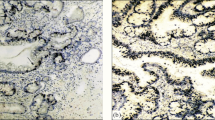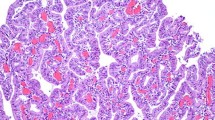Abstract
Sixty-two colorectal adenomas 10 mm or less in diameter, resected endoscopically and fixed in formalin for 3 days or less, were evaluated with antiproliferating cell nuclear antigen/cyclin (PCNA) monoclonal antibody to investigate the cell proliferation kinetics. All lesions were tubular adenoma with low-grade atypia. These lesions were classified by macroscopic type as: I; polypoid (n=14), IIa; flat or hemispherically elevated (n=28), IIb; plain, flat (n=6), IIc; depressed (n=9), and IIa+IIc slightly elevated with a central depression (n=5). The distribution patterns of PCNA-positive cells were divided into two types; diffuse distribution of positive cells throughout the crypts (diffuse type) and localized distribution, mainly in the upper portions of the crypts (superficial type). The distribution pattern of proliferating cells was correlated with the size and macroscopic type of adenoma. Type IIc, IIa+IIc, IIb, smaller (≤5 mm) IIa and smaller (5 mm) I adenomas showed the superficial type pattern. Larger (>5 mm) adenomas of type I and IIa had the diffuse type pattern. The formation of a proliferative zone in small adenomas, as in normal mucosa, but in opposite locations, suggested a lower cell proliferation activity. In the elevated type (I and IIa) adenomas, however, the change in the distribution pattern of proliferating cells from the superficial to the diffuse type would lead to growth in size.
Similar content being viewed by others
References
Muto T, Bussey HJR, Morson BC. The evolution of cancer of the colon and rectum. Cancer 1975;36:2251–2270.
Ajioka Y, Watanabe H, Honma T, et al. Depressed type early colorectal carcinoma with special reference to the diagnosis of endoscopically resected specimens (in Japanese). Clin Gastroenterol 1992;7:393–403.
Kuramoto S, Ihara O, Sakai S, et al. Depressed adenoma in the large intestine. Dis Colon Rectum 1990;33:108–112.
Wolber RA, Owen DA. Flat adenoma of the colon. Hum Pathol 1991;22:70–74.
Muto T, Kamiya J, Sawada T, et al. Small “flat adenoma” of the large bowel with special reference to its clinico-pathologic features. Dis Colon Rectum 1985;28:847–851.
Ajioka Y, Watanabe H, Honma T, et al. Significance of small carcinoma of the large intestine (in Japanese with English abstract). Endondosc Dig 1990;2:969–977.
Nakamura K. Depressed type early colorectal cancer, comments on case reports (in Japanese). Stomach Intest 1987; 22:961–963.
Watanabe H, Ishiguro S, Iwashita A, et al. Case presentation of early colorectal carcinoma and its pathological diagnosis by leading pathologists (in Japanese). Stomach Intest 1992;27: 633–671.
Cole JW, McKalen A. Studies on the morphogenesis of adenomatous polyps in the human colon. Cancer 1963;16:998–1002.
Deschner EE, Lewis CM, Lipkin M. In vitro study of human rectal epithelial cells. I. Atypical zone of [3H] thymidine incorporation in mucosa of multiple polyposis. J Clin Inest 1966; 42:1922–1928.
Bleiberg H, Mainguet P, Galand P. Cell renewal in familial polyposis, Comparison between polyps and adjacent healthy mucosa. Gastroenterology 1972;63:240–245.
Roncucci L, Scalmati A, de Leon MP. Pattern of cell kinetics in colorectal mucosa of patients with different types of adenomatous polyps of the large bowel. Cancer 1991;68:873–878.
Risio M, Coverlizza S, Ferrari A, et al. Immunohistochemical study of epithelial cell proliferation in hyperplastic polys, adenomas, and adenocarcinomas of the large bowel. Gastroenterology 1988;94:899–906.
Potten CS, Kellett M, Roberts SA, et al. Measurement of in vivo proliferation in human colorectal mucosa using bromodeoxyuridine. Gut 1992;33:71–78.
Johnston PG, O'Brien MJ, Dervan PA, et al. Immunohistochemical analysis of cell kinetic parameters in colonic adenocarcinomas, adenomas, and normal mucosa. Hum Pathol 1989; 20:696–700.
Koido S, Shimoda T, Immunohistochemical study of proliferative cells in colorectal adenoma and carcinoma (in Japanese with English abstract). Jpn J Gastroenterol 1992;89:2664–2672.
Okano S, Obara T, Okuyama S, et al. Detection of proliferative cells in colorectal carcinomas and adenomas by monoclonal antibody to DNA polymerase α (in Japanese with English abstract). Jpn J Gastroenterol 1990;87:2444–2450.
Honma T. Study of epithelial cell proliferation in colorectal mucosa by monoclonal antibody against DNA polymerase α (in Japanese with English abstract). Niigata Med J 1992;106:89–97.
Bravao R, Frank R, Blundell PA, et al. Cyclin/PCNA is the auxiliary protein of DNA polymerase-δ. Nature 1987;326: 515–517.
Perlich G, CK Tan, M Kotura, et al. Functional identity of proliferating cell nuclear antigen and a DNA polymerase-δ auxiliary protein. Nature 1987;326:517–529.
Grant P, Degraef C. Cyclin/PCNA immunostaining as an alternative to tritiated thymidine pulse labelling for marking S phase cells in paraffin sections from animal and human tissue. Cell Tissue Kinet 1989;22:383–392.
Hall PA, Levison DA, Woods AL, et al. Proliferating cell nuclear antigen (PCNA) immunolocalization in paraffin sections: An index of cell proliferation with evidence of deregulated expression in some neoplasms. J Pathol 1990;162:285–294.
Jain S, Filipe MI, Hall PA, et al. Prognosis value of proliferating cell nuclear antigen in gastric carcinoma. J Clin Pathol 1991; 44:655–659.
Yu CCW, Fletcher CDM, Newman PL, et al. A comparison of proliferating cell nuclear antigen (PCNA) immunostaining, nucleolar organizer region (AgNOR) staining, and histological grading in gastrointestinal stromal tumours. J Pathol 1992; 166:147–152.
Kobayashi M, Watanabe H, Ajioka Y, et al. PCNA-positive cell distribution in depressed types of early carcinoma and adenoma of the large intestine. Gastroenterol Jpn 1992;27:684.
Watanabe H, Ajioka Y, Yamaguchi M, et al. Relationship of colorectal adenoma and colorectal carcinoma: Based on the author's diagnostic criteria (in Japanese). Stomach Intest 1989; 24:253–259.
Kato N, Watanabe H, Sato M, et al. PCNA staining and its problems in gastrointestinal tract. Gastroenterol Jpn 1992; 27:561.
Murakami T. Pathomorphological diagnosis. Gann monograph on cancer research. vol 1 Tokyo: University of Tokyo Press. 1974;53–55.
Watanabe H. Depressed type early colorectal cancer, Comments on case reports (in Japanese). Stomach Intest 1987;22: 964–966.
Morris GF, Mathews MB. Regulation of proliferating cell nuclear antigen during the cell cycle. J Biol Chem 1989;264: 13865–13864.
van Dierendonk JH, Wijsman JH, Keijzer R, et al. Cell-cycle-related staining pattern of anti-proliferaing cell nuclear antigen monoclonal antibodies. Am J Pathol 1991;138:1165–1172.
Wijsman JH, van Dierendonk JH, Keijzer R, et al. Immunoreactivity of proliferating cell nuclear antigen compared with bromodeoxyuridine incorporation in normal and neoplastic rat tissue. J Pathol 1992;168:75.
Kamel OW, LeBrun DP, Davis RE, et al. Growth fraction estimation of malignant lymphomas in formalin-fixed paraffinembedded tissue using anti-PCNA/cyclin 19A2. Am J Pathol 1991;138:1471–1477.
Lightdale C, Lipkin M, Deschner E: In vitro measurements in familial polyposis: Kinetics and location of proliferating cells in colonic adenomas. Cancer Res 1982;42:4280–4283.
Author information
Authors and Affiliations
Rights and permissions
About this article
Cite this article
Kobayashi, M., Watanabe, H., Ajioka, Y. et al. Proliferating cell nuclear antigen/cyclin expression in small adenomas of the large intestine in relation to size and macroscopic appearance. J Gastroenterol 29, 139–146 (1994). https://doi.org/10.1007/BF02358674
Received:
Accepted:
Issue Date:
DOI: https://doi.org/10.1007/BF02358674




